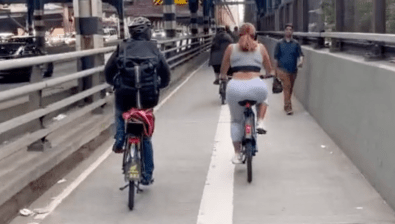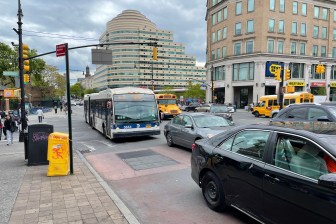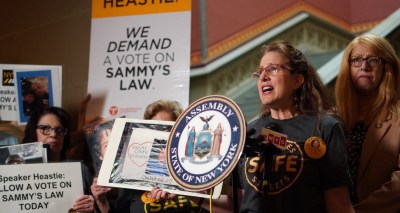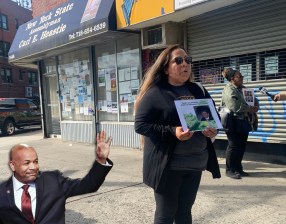Partial Service Restorations Aren’t Good Enough For City Pols, TWU

Across the city, New Yorkers are still demanding their transit back. A dozen elected officials joined the Transport Workers Union on the steps of City Hall this afternoon to demand that all of 2010’s MTA service cuts be restored. Around one-third of the eliminated service will be reinstated under a plan released by the MTA last week.
“It’s as if a knife were put into the heart of Queens twelve inches,” said City Council Member James Sanders, referring to the 12 bus lines that were cut in the borough, “then withdrawn five inches.”
The labor-organized rally boasted an lengthy roster of city politicians, with remarks from State Senators Gustavo Rivera and Adriano Espaillat; Assembly Members Hakeem Jeffries, Helene Weinstein, Rafael Espinal, Nick Perry and William Colton; and City Council Members Leroy Comrie, James Sanders, Elizabeth Crowley, Gale Brewer and Letitia James. Also in attendance were advocacy organizations like UPROSE, WE ACT, Transportation Alternatives and the Working Families Party.
Many of the speakers were in office in 2008 and 2009, when legislators had the opportunity to address MTA funding shortfalls by enacting congestion pricing or bridge tolls. Some voted to fund the transit system via road pricing, while others, including Jeffries, Comrie, and Colton, opposed it. Today, all of them reiterated the need to make the transit system whole, bringing subway and bus service back to 2010 levels or better, including by re-hiring laid off station agents or cleaning staff. “My people need to get to work,” said Espinal. “That’s the only way they’ll get out of poverty.”
The pols who did more than simply state the importance of transit differed on how to make service restorations possible. Some put the onus on the state and city to increase funding for the MTA and could point to their own support for legislative measures to shore up the agency’s finances.
“I have worked in Albany to support a dedicated fund,” said Weinstein. “That’s something that when we return, we clearly have to work harder to put in place.” Rivera, too, called for increased dedicated funding, while Colton suggested starting with lockbox legislation to ensure that existing dedicated revenues actually make it into the transit system.
Others, however, claimed that the MTA didn’t need any new funds.
“With the surplus the MTA had, they could have restored all the service,” said Comrie. “The MTA has the funds,” agreed Crowley. Some TWU members wore shirts reading “MTA Can Pay,” and Local 100 President John Samuelsen repeated the claim that the MTA could afford to restore service.
The “surplus” in question was likely the MTA’s “Other than Pension Benefits” fund, which the TWU has called on the MTA to spend down to pay for raises and service restorations. The MTA puts away the money in that fund to pay for retirees’ health care and believes it would be extremely fiscally irresponsible to spend it, given the eventual $13 billion cost of providing retiree health care, according to the Daily News. Independent analysts believe that the MTA needs new revenues in order to preserve and expand service, especially with the threat of continued raids by the state, the cuts to the payroll mobility tax and a capital program being paid for with debt.





